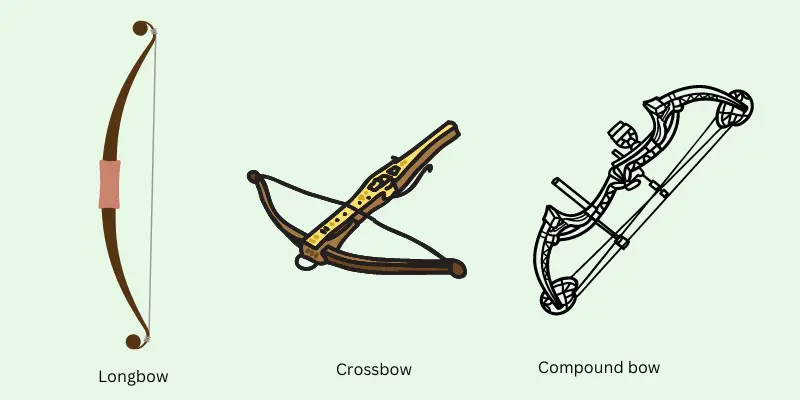If you have been into hunting for a long time, you presumably know longbows, recurve or compound bows mainly lead the market. But particularly, which one should you buy? We will unfold everything here.
So, what are the key differences between longbow vs recurve vs compound bow? The main difference lies in their shooting accuracy. While longbows make hunters suffer due to a lack of power, the other two types can accelerate shooting power. Also, recurve and compound bows contain bow sights for shooting flexibility while longbows don’t have that.
And, that’s not all that we would like to brief here. Throughout this article, we will break every factor down so that you achieve a better understanding. So, let’s get into the business to help you in purchasing an ideal bow.
Table of Contents
- Longbow vs Recurve vs Compound Bow: A Quick Overview!
- Longbow vs Recurve vs Compound: In-depth Comparison
- Final Verdict
- FAQs
- Conclusion
Longbow vs Recurve vs Compound Bow: A Quick Overview!
What are the factors that matter while buying a bow? Bet, there are several names going to pop up apart from common factors such as sizing, robustness, etc. Before expanding them all in-depth, let’s have a quick look.
| Compared Factors | Longbow | Recurve Bow | Compound Bow |
| Bow Sights | None | Containing | Containing |
| Structure | Longer design | Concise design | Complicated, no actual shapes |
| Draw Weight | 40 to 70 lbs | Lightweight, less than 70 lbs | More or less 70 lbs |
| Power And Shooting | Lack of power | Precision requires for powerful shoots | Most powerful |
| Maintenance | No complex maintenance procedures | Effortless | Tough for beginners |
| Fix | No way to fix | Easier | Complex |
But which one to choose? Deciding is not that easy just by going over some quick snippets. Let’s come up with our decision once you finish the next section.
Longbow vs Recurve vs Compound: In-depth Comparison
It’s time to demonstrate the details of longbow vs recurve vs compound. It will make your decision-making strategy effortless. Now, let’s get right into it.
Bow Sights
Don’t you want to gain accuracy out of your bow consistently? Then, bow sight is one of the crucial factors impacting accuracy and overall strength. Bow sights are specialized devices featuring one or more pins.
They also come with a circle, lens, and other symbolic things that keep hunters focused during hunting.
And, hitting the target more accurately becomes possible. If you compare these three, two of them- recurve and compound bows bring sights. In the meantime, having no sights in the longbow is its demerit.
As a result, either the bow is recurved or compound, you can point the sight in the middle of your target and shoot. This approach provides hunters enough flexibility and a reference point to aim more.
Interestingly, shooting without any sights with compound ones might not create any trouble. Still, you can avail enough field of view and generate accuracy.
What if you already have a longbow and still want the best outcome out of this? Very much possible!
But see, working on a DIY method called ‘string walking’ can get you an alternative solution. It’s a time-consuming approach. However, it’s always better to have something than nothing!
Draw Weight
You will mostly see top bows available in the market come at around 70 lbs of draw weight. In this scenario, 70 lbs are quite good in generating power for a standard bow.
Interestingly, what a compound bow having this much weight can perform is almost inconceivable for a same-weighted recurve bow.
Along with that, as a hunter, you should feel the less weight, the better. At the same time, recurve bows generally come with less weight compared to a compound bow.
The cams and additional strings boost the compound’s overall weight. Though it’s not a big issue, you should stick to utilizing lightweight bows such as recurve ones. Finally, what about the longbow?
It stays within 40 to 70 lbs of the draw weight. But still, compared to recurve bows, you might not find enough offerings in longbows.
Power And Shooting
Yes, these two factors here we could discuss in different segments. But usually, they altogether impact the most while shooting the bow. Well, a longbow is one of the earliest bow types and is commonly used. But you may find less robustness here.
So, before bringing it in, consider its lack of power. But yes, you will undoubtedly feel so comfortable with it for its easy-to-shoot nature.
This bow type is very forgiving. At the same time, not so much precision is required for a successful hunting completion.
Besides, a recurve bow is constructed to be more robust than the longbow type. Recurve limbs are the best feature of recurve bows which allow more energy to store at a time. As a result, more powerful shots tend to be happening.
Moreover, swinging from the target might occur due to having more torque. Along with that, enough precision is required to get the job done perfectly.
And finally, compound bows are the best of all three. More specifically, 85 to 100-pound compound bows bring the most powerful nature.
They can travel by air at the least time. Targets are hit harder via them. Relevantly, their penetration quality of them indicates deeper and broader wounds.
Maintenance
Everything impacting during the hunt is not the only thing that you should focus on! After usage, we require proper maintenance in order to keep it going for a longer period. Could you let the bow go for real quick after buying it at a higher cost?
Bet, you don’t! Also, keeping your bow in carelessness can lead you to charge higher maintenance fees afterward. A great hassle, isn’t it?
Longbows know the hunter’s feelings so they don’t carry any complex maintenance procedures. It’s easy to restore if you ever require it. But remember, it will be permanently gone if your hunting ends up with broken pieces of longbows.
No way to fix them is the biggest drawback of longbows. But look at the recurve bows! They will not demand you buy a brand new one even if they get broken or separated. Yes, it’s easy to repair and you will feel effortless.
What about their limbs? They also can be suitably replaced and repaired. However, extensive damages might suggest you buy a new bow.
On the other hand, fixing a compound bow is very complex. Also, doing the string is tough if you are not a professional hunter. So, a minimum level of skills and knowledge is required.
Seems like recurve is preferable other than longbows and compound bows, doesn’t it?
Structure
The most basic difference between the three models is that of the structure. These three bow types contain considerably different structures with a variety of traits.
Longbow- the name suggests a long design in its structure. Also, this type is quite heavier than usual bows. You will find them shaped like the letter D. It seems like a semi-circular shape too.
Towards you, the limb’s end parts are situated. This particular design has been done as it only can curve from the center spot.
In the meantime, you will find the recurve design the most concise. And, its limbs curl away from the hunter. That means, featuring two curves is its key structure. One curve goes to the center while the other one stays at the end part.
Amongst them, compound bows contain the most complicated build structure. You can not compare them in any letters or shapes particularly.
Unlike the other two bow types, compound bows carrying limb ends do not feature any curves. However, their wheels might permit the forces to compound.
Final Verdict
Longbows are unlikely to win over the other two bows for not being able to offer more features. At the same time, compound bows are complicated and harder for newbies.
But considering all factors, we feel recurve bows staying a bit ahead of others.
FAQs
What is the contrast between a compound bow and a traditional bow?
Compound bows come with additional strings, cables, and even cams making the key contrast between compound and traditional bows.
Cams situated at the compound are usually found on the limb’s end part. Modern compounds come shorter in size and more compact compared to traditional ones.
What is the point of a compound bow?
A compound bow can multiply your input force which gets enabled through executing like a block and tackle. It also can store more conceivable energy in the curved limbs. This approach you can not have through any traditional bows of identical draw weight.
Is 70 lb draw too much?
Mostly, professional archers prefer shooting from 60 to 70 lbs. Some are capable of expanding up to 90 lbs which you will find very rare and unpopular.
However, a comfy draw weight stands depending on the shooters. As you can find more advanced bows nowadays, below 40 lbs can be efficient enough to harvest big animals.
Is a recurve bow good for beginners?
Yes. If you are a beginner, you will learn easily via this type of bow. Recurve bows are highly lightweight so that you feel so comfortable and are handy to carry and shoot within the least time.
Fewer attached equipment and technical detailing keep it straightforward for users. You can not find any better than this while wanting your form to be reshaped.
Can I shoot a compound bow without an arrow?
Yes, but not recommended. Shooting your compound bow without an arrow might not bring any damage to your bow.
You can draw the bow perfectly till you keep away firing. And, you have to bring the string to its regular position for security.
Conclusion
Now you know the major differences between the longbow vs recurve vs compound bows.
Our target was to explore their differences by discussing factors. Hopefully, now you carry clearer ideas on these bows. Next time you go to purchase bows, you know which areas to focus on.

